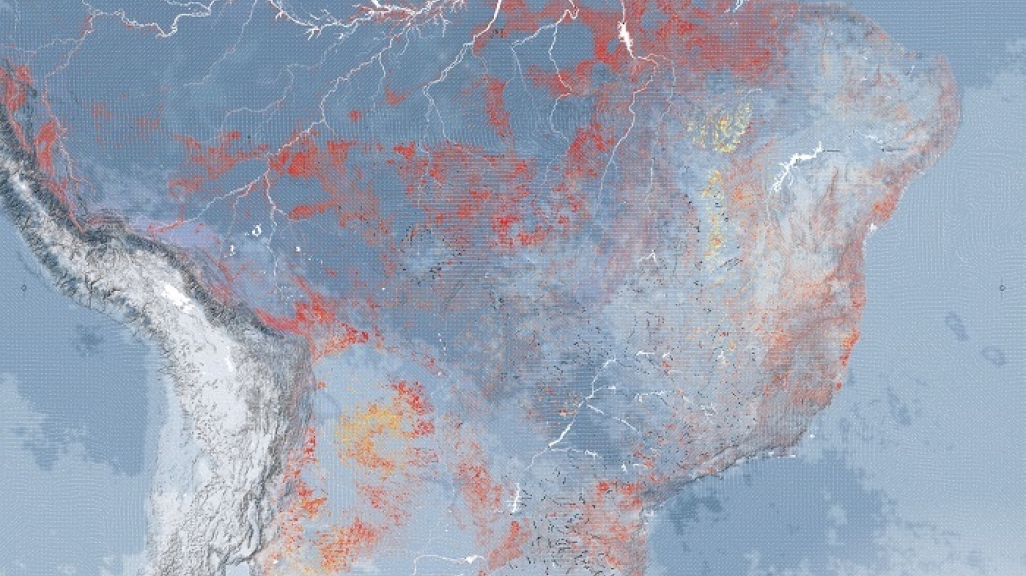Americas Society Presents Walls of Air: The Brazilian Pavilion at the 16th Venice Architecture Biennale
Americas Society Presents Walls of Air: The Brazilian Pavilion at the 16th Venice Architecture Biennale
Walls of Air is the result of collaborative research with more than two hundred professionals of social sciences, visual arts, geography, law, medicine, and politics, whose dialogue is aimed to build a common agency.
Walls of Air: The Brazilian Pavilion at the 16th Venice Architecture Biennale
On view at Americas Society from June 12 through August 3, 2019
Curators: Sol Camacho, Laura González Fierro, Marcelo Maia Rosa, and Gabriel Kozlowski with the assistance of Diana Flatto and Carolina Scarborough.
Press Preview: June 10, 5:00 p.m.
Opening Panel: June 13, 6:30 a 8:30 p.m.
Press Contact: mediarelations@as-coa.org | +1 212-277-8333
New York, May 28, 2019 —Americas Society is pleased to present Walls of Air, The Brazilian Pavilion at the 16th Venice Architecture Biennale, curated by Sol Camacho, Laura González Fierro, Marcelo Maia Rosa, and Gabriel Kozlowski with the assistance of Diana Flatto and Carolina Scarborough.
“Walls of Air is a research exhibition model that maps contemporary Brazil beyond its frontiers, asking questions about social inclusion, political transparency and environmental matters that have local, regional, as well as planetary impact in a short term,” says Gabriela Rangel, director and chief curator of Visual Arts at Americas Society.
Organized by four architects with an interdisciplinary approach, the exhibition attempts to uncover the visible and invisible walls that have built —and divided— Brazil through the country’s social and environmental fragmentation. Responding to the theme of the 16th Venice Architecture Biennale in 2018—“Freespace,”— the team of curators of the Brazilian Pavilion posited questions about how spatial and social restrictions have prevented Brazil from establishing a more egalitarian and democratic public sphere after its project of modernization. The resulting exhibition suggests that, if a democratic Brazil is to be built, its current problems must be debated from all vantages and by all citizens.
“This exhibition is an inquiry into the causes of the spatial divides that fragment Brazilian society and the environment we live in, rather than unite us. From immigration issues to the formation of our national borders, each one of the ten maps brings to the foreground a specific theme that we believe is in urgent need of discussion, not only in Brazil but also in all Latin American countries,” co-curator Gabriel Kozlowski said.
The curators developed ten large-format cartographies that promote critical awareness of the spatial and conceptual barriers that have resulted from Brazil’s urbanization processes and make visible the effects these processes have had on the natural environment.
The research involved builds a common ground and allows for the development of a democratic fabric amongst different communities. The maps range in scale from a single city to the entire Brazilian territory and its relation not only to Latin America but to the world at large. This use of multiple scales suggested to the curators that the first wall to be torn down is the wall that separates architecture from other disciplines. Walls of Air is the result of collaborative research with more than two hundred professionals of social sciences, visual arts, geography, law, medicine, and politics, whose dialogue is aimed to build a common agency. Co-curator Marcelo Maia Rosa added, “A big part of our exhibition is an attempt to bring awareness to the interdependency between architecture and other disciplines outside the architectural realm.”
From the way capital is distributed in the Brazilian territory to the way deforestation in the north of the country impacts life in the south, each map foregrounds a pressing theme while emphasizing the need to conceive of architecture as a means of rethinking the boundaries within our cities. The result of visualizing extended data sets from both national and international institutions, including the Brazilian Institute of Geography and Statistics, the Federal Police of Brazil, NASA, and the Global Forest Watch, Walls of Air proposes some first steps toward challenging—and transgressing—these boundaries.
“The exhibition at AS/COA is an opportunity to expand the dialogue we started in Brazil to other geographies in America. Moving this exhibition from Venice to the U.S. means bringing it closer to home, where the issues we discuss are more pertinent and acute,” stated co-curator Laura González Fierro.
“Americas Society has been a major force in defining the dialogues that help bring the different countries in the Americas closer together, and we are glad to have Walls of Air contributing to this mission,” said co-curator Sol Camacho.
The presentation of Walls of Air at Americas Society is made possible by public funds from the New York City Department of Cultural Affairs in partnership with the City Council, and by the generous support from the Consulate General of Brazil in New York and the Garcia Family Foundation.
Americas Society gratefully acknowledges the support from the Arts of the Americas Circle members: Estrellita Brodsky; Galeria Almeida e Dale; Kaeli Deane; Diana Fane; Isabella Hutchinson; Carolina Jannicelli; Vivian Pfeiffer and Jeanette van Campenhout, Phillips; Luis Oganes; Roberto Redondo; Erica Roberts; Sharon Schultz; Herman Sifontes; and Edward J. Sullivan.









